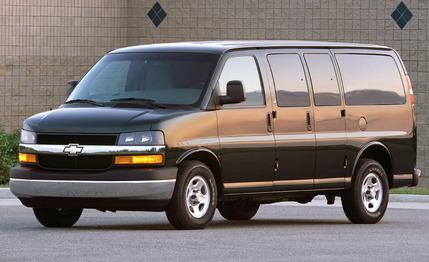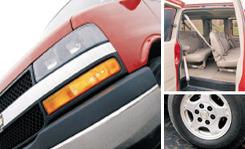 Short Take Road Test
Short Take Road Test
In 1996, designers at the then Chrysler Corporation made a startling revelation: Providing rear side doors on both sides of a van enhances its usefulness. In terms of its impact on Western civilization, this breakthrough innovation ranks somewhat behind the invention of television but ahead of the Popeil Pocket Fisherman and the Clapper.
What's even more startling is that it took another seven years--and another corporation--to apply this principle to full-size vans; this van, for example--the Chevy Express--as well as its Professional Grade (and essentially identical) counterpart from GMC Truck, the GMC Savana. Both the Express and the Savana offer a driver's-side rear-door option for 2003--or, to be more accurate, doors: a pair of them, side-hinged portals that open clamshell fashion from the middle, 60/40, just like the pair on the opposite side of the vehicle. No sliding doors here.
It's amazing how much this innovation--a first in full-size vans--improves access to the interior. Which makes it even more amazing that no one's done it before. But then people probably said the same thing about the Hula Hoop.

The left-side-door option isn't the only improvement to the Express and Savana. GM's big vans have new (and, of course, stiffer) three-piece box-section frames, updated editions of GM's Vortec V-8 truck engines, a four-wheel-drive option, all-disc brake systems with anti-lock brakes as standard equipment, upgraded interiors, an OnStar option, and a modest face lift, to hit the highlights.
We decided to put one of the '03 vans--a regular-wheelbase (135.0 inches versus 155.0 inches for the long, rear-drive-only version) 1500-series Express with all-wheel drive and, of course, the extra set of side doors--through its paces. The exercise consisted of a trip to the test track, a little local hauling, and then putting the van to work for a Sports Car Club of America race weekend.
Track-test results were acceptable but not extraordinary. Powered by GM's 5300 Vortec V-8 (5.3 liters, 285 horsepower, 325 pound-feet of torque), the Express propelled its 5820 pounds to 60 mph in 8.7 seconds and through the quarter-mile--where the small-barn aerodynamics of a van really begin to assert themselves--in 16.7 seconds at 83 mph.
Similarly, considering the system upgrades, braking performance was rather ordinary--214 feet from 70 mph to a standstill, although we were favorably impressed by the improved pedal feel versus that of the previous Express, as well as the system's resistance to fade.
On the road, however, with about 5000 pounds of trailer and race car hooked up, it was a different story. The Vortec V-8 handled the trailer easily, with enough snort left over for passing on two-lane highways. And the four-wheel-drive system was particularly helpful in a rain-soaked grass paddock.
The four-wheel-drive system isn't like the hard-core setups offered on Chevy pickups. The major component is the full-time transfer case that employs a center differential with viscous limited slip. This isn't nearly as effective as systems with locking differentials. But it's better than the conventional rear-drive approach, and it did make a difference when we were extracting a loaded trailer from that slippery paddock--while around us others were slippin' and slidin'.
Like Ford's E-series vans, the Express and the Savana come in a variety of sizes, payload ratings, and seating configurations, from pure cargo haulers to 15-passenger church specials. Our sample van had three rows of seats, which still left plenty of space for racing cargo, including two sets of spare wheels, a toolbox, a floor jack, jack stands, a cooler, chairs, and an air tank.
Ford has pretty much owned the full-size-van market, and the van-conversion business, for a long time, thanks largely to its superior chassis. General Motors has been the longtime runner-up, but a distant runner-up.
Judging by this new Express, we'd say that gap is going to shrink. A lot.